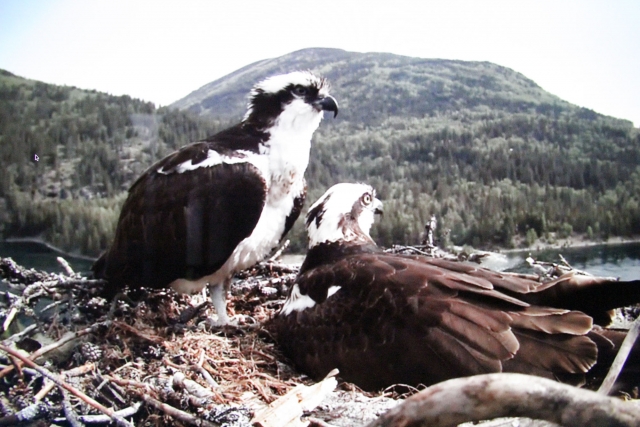Osprey webcam drama — Life goes on
Little Nel – gender yet undetermined — is doing well in Delta after a free ride on an airplane.
Nel is the Osprey chick, who became famous on the internet as the only surviving chick of three in a nest high above the Kootenay River in Grohman Narrows.
The webcast was made possible by the joint efforts of Nelson Hydro and Columbia Wireless.
From the moment the Osprey pair arrived on their nest in May, thousands of viewers on the internet watched a drama unfold that may be common in Nature but shocked viewers by the harsh reality of death and starvation.
“This was a great learning experience for everyone,” said Nelson line manager Doug Pickard. “All things being equal, if there’s another occupation of the nest next year we’ll run the camera again.”
Last year a “decoy” pole was built near Nelson Hydro’s pole west of Nelson in an effort to attract the Ospreys who wanted to nest atop a dangerous transformer. A pair of Ospreys began building a nest on the decoy and moved in this spring, the female laid three eggs, they hatched, and all was well.
But then reality set in. One of the chicks died after the male Osprey flew into a power line, killing himself in the process.
That left mama alone with two chicks—one healthy, one looking weak and no one to fish for them.
With the world looking on, Nelson Hydro decided to feed the birds.
Local fishers offered to do the father’s job and supplied fish for the mother, but the weak one succumbed leaving mother Nellie and little Nel.
Cranbrook raptor specialist Bill Dove is critical of what followed.
“I believe human intervention in the form of providing fish interrupts several ‘natural’ processes that would occur,” said Dove.
“The most important of which is the survival of the female, not the young Osprey. She is a proven breeder and more important to her species than this year’s young.”
According to Dove, the female began fishing, but stopped once human intervention began. Dove believes the intervention created “a fair level of stress for the female.”
Dove also hypothesizes that the intervention may have eliminated the possibility of a new mate coming forth.
Once the female began refusing food, OWL (Orphaned Rehabilitation Society) in Delta, BC, offered to rescue the chick and Nelson Hydro accepted the offer.
Public opinion on the net by this time was formidable: save the chick.
“Pacific Coastal Airlines in Trail got the bird to Vancouver by 11 a.m.,” said Pickard. “They fly those kind of passengers for nothing.”
Now supplied with freshly caught trout, little Nel has gained 200 grams in two days, which Martina Versteeg, a member of the bird care staff at OWL, said is optimistic.
“He’s doing really good,” said Versteeg. “And luckily for Nel, we have an older adult Osprey with an injured wing. So he’s growing up knowing he’s an Osprey.”
She said they haven’t determined the sex of Nel yet, but refers to the bird as “he”.
OWL is currently rehabilitating 303 birds of prey. Normally they take in about 500 a year.
The goal for Nel, Versteeg said, is to get him back in the wild.
In a few weeks to a month it is hoped he will be strong enough to move to the trout pool where he will be able to fish for himself, although Ospreys are hard to rehabilitate normally, said Versteeg.
“They only eat fresh live fish, and water intake is important,” she said.
Whether or not there is a somewhat happy ending to this drama is too early to tell. It has been reported, said Pickard, that mama has returned to the nest and is being courted by another male.
Nelson Hydro will leave the camera on for another week to see if the mother returns.
It is speculated that the first pair may have been young and inexperienced, unable to cope with the loss and stress caused by the death of the father, which resulted in the female’s behavior.
But Dove was hoping for a different outcome.
“An alternative that is very successful with young removed from a nest is to foster that bird(s) into an active wild nest,” he said.
“This provides that young Osprey with the proper imprinting model — not some human hand feeding the nestling — and an adult to teach it fishing skills upon fledging which is far more realistic that any captive situation.
“Though disturbing to many viewers of the nest cam, mortality rates in Osprey in the first year are significant enough to only allow for a slow to stable population growth.
“This reality is to the benefit of Nature’s control of the predator.”
Dove said too many chicks lead to more problems than the currently normal rate of one young per year.
“It is not uncommon to fledge more than one nestling per year but uncommon to have more than one survive to become a yearling, especially in a species with such a lengthy migration, and not all these yearlings become successful breeders,” he said.
For his part, Pickard is hoping that mama would find another mate, come back to the nest for next year and the educational experience will resume for thousands of viewers.
Nelson Hydro will be posting a video of the rescue on their websites: www.nelson.ca or www.columbiawireless.ca shortly.






















